Basilica of Saint John Lateran
Contents
History
The Exterior of the Basilica
The Interior of the Basilica
The Holy Stairs and the Sancta Sanctorum
The Papal Archbasilica of the Most Holy Savior and Saints John the Baptist and John the Evangelist, more popularly known as Saint John Lateran, holds the prestigious title of mater et caput (mother and head) of all churches in Rome and the broader world. It is poised to play a pivotal role during the 2025 Jubilee. As a beacon of universal Christianity, it will draw thousands of pilgrims who will gather to participate in the jubilee events, celebrating their faith and experiencing spiritual renewal at one of the most pivotal sites of Christian tradition
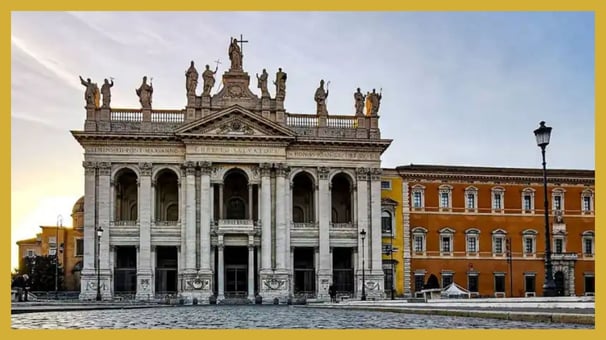

History
The Basilica of Saint John Lateran, revered as the mother of all churches in Rome and globally, encapsulates nearly two millennia of spirituality, art, and politics. This remarkable temple has been central to numerous pivotal events not only for Rome but for all of Christendom, including the Jubilees which have notably shaped the Church's journey.
The Origins Between Legend and Reality
The foundation of the Basilica of Saint John Lateran traces back to the era of Emperor Constantine. In the 4th century, Constantine gifted to then Pope Saint Miltiades a plot that included the palatial home of the distinguished Laterani family of the Roman Empire. After triumphing over religious conflicts and implementing the Edict of Milan in 313, which endorsed religious tolerance, Constantine commissioned the construction of the first Christian basilica on this imperial land. In 324, Pope Sylvester I dedicated it to Christ the Savior, marking a crucial moment for the Christian community and establishing a sacred site destined to welcome millions of pilgrims in the ensuing centuries. In the 9th century, Pope Sergius III added a dedication to Saint John the Baptist, enriching its spiritual and religious significance. Later, in the 12th century, the dedication to Saint John the Evangelist was introduced by Pope Lucius II, bestowing upon the basilica its comprehensive title that it proudly bears to this day.
One of the most famous legends about the basilica's origin involves Constantine's struggle with leprosy. Plagued by this severe ailment, he was visited in a dream by Saints Peter and Paul, who declared he would find a cure only through baptism. In response, Constantine summoned Pope Sylvester I, who had been hiding from persecution on Mount Soratte. The pope returned to baptize the emperor, who miraculously recovered from leprosy, and in gratitude, constructed the basilica of Saint John.
The Ancient Basilica
Originally known as the Basilica Aurea for its majestic beauty, the original structure bore a strong architectural resemblance to today's building, with perimeter walls largely paralleling the modern ones. Inside, five expansive naves unfold, delineated by elegant marble columns crowned with Corinthian capitals. The transept spanned only across the three central naves, while the two outer naves were shorter, ending in two square halls that slightly jutted beyond the lateral walls.
The Basilica sustained extensive damage due to looting and earthquakes, undergoing numerous reconstructions over the years, mirroring the vicissitudes and transformations of Rome itself. For approximately 1000 years, from its foundation until the early 14th century, the Basilica of St. John Lateran and the surrounding buildings served as the papal seat. When the popes relocated their residency to Avignon, France, the Lateran was left in a state of partial neglect. Upon the papacy's return to Rome, the pontiffs favored the Vatican over the Lateran See.
The Restoration by Borromini
Francesco Borromini was commissioned by Pope Innocent X to oversee the restoration of the basilica in preparation for the Jubilee of 1650. The restoration commenced in 1646 and progressed rapidly to ensure the basilica was inaugurated for the Holy Year. By 1649, the restoration was complete. Borromini opened five large arches along the nave walls, alternated by pairs of giant pillars with Corinthian capitals; between these pillars, 12 niches were erected where, years later, statues of the Apostles were placed.
Borromini also undertook the redesign of some internal chapels and the restructuring of the cloister, applying his signature Baroque style, marked by bold forms and structural innovations that heralded a new era in Italian architecture.
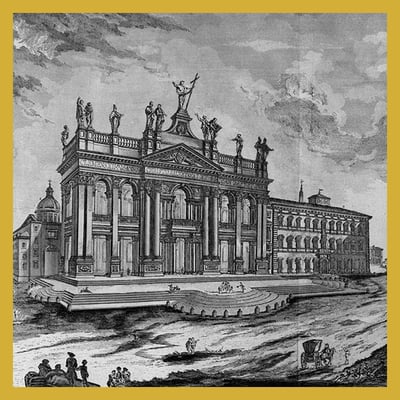

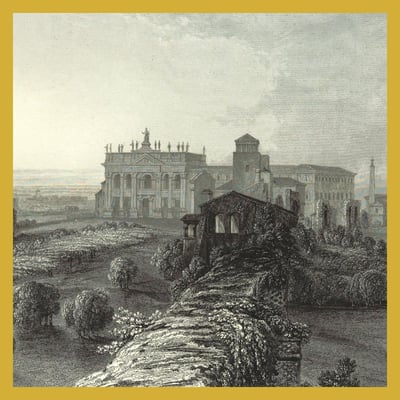

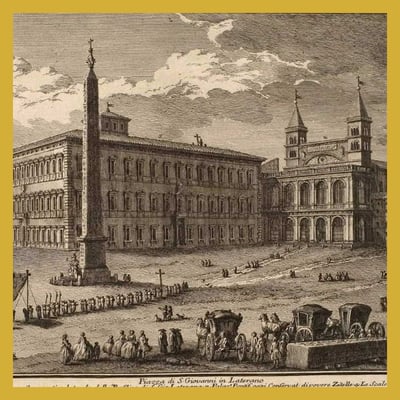

The Exterior of the Basilica
The exterior of the Basilica of St. John Lateran serves as a definitive statement of ecclesiastical architecture, reflecting the stylistic evolution it has undergone through the centuries. Situated in the heart of Rome, this basilica not only acts as the Pope's cathedral but also plays a pivotal role during the Jubilee, when the Holy Door is solemnly opened to welcome believers from around the globe.
The Facade
Designed by Alessandro Galilei in the 18th century, the current facade facing the Piazza di San Giovanni in Laterano strikes a perfect balance between classical grandeur and late Baroque elegance. The imposing facade features a broad staircase leading to five doors, the central one being particularly grand and reserved for papal use. This grand door, framed by Corinthian columns and crowned by a pediment, displays statues of Christ and various saints, creating an iconic representation of the spiritual gateway into Rome.
Above the facade, the loggia added by Borromini in the mid-17th century houses statues of the Apostles and other biblical figures, each expertly carved, overseeing the eternal city. This loggia not only enhances the basilica's aesthetic appeal but also serves as a visual link between the basilica and its faithful, further elevating its status as a symbol of universal Christianity.
The Holy Door
Located at the far right of the facade, the Holy Door is a focal point during the Jubilee. According to Catholic tradition, passing through this door during the Holy Year grants indulgence and remission of sins. Decorated with reliefs depicting biblical scenes and pivotal church history events, the door acts as a powerful visual reminder of the Christian heritage and the promise of forgiveness.
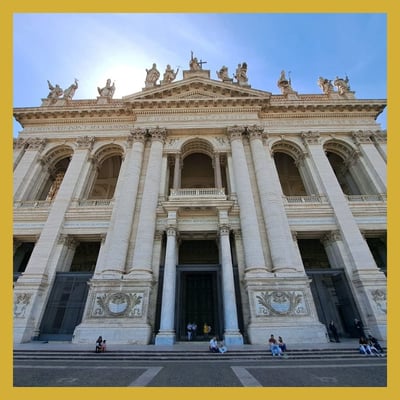

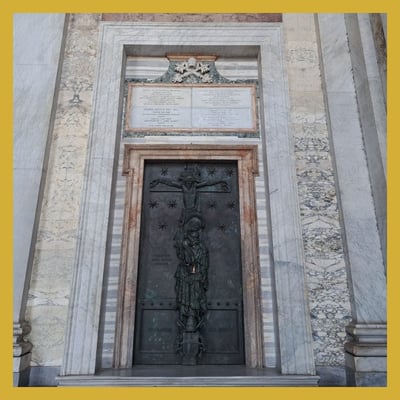

The Interior of the Basilica
The interior of the Basilica of St. John Giovanni Lateran, with its monumental scale and intricate decorations, stands as a vivid testament to both the historical and spiritual significance of this site for Rome and the Catholic world. The basilica not only hosts pivotal Jubilee rites but also serves as an architectural archive illustrating the evolution from the Medieval period to the modern age.
Description
Upon entering the basilica, visitors are immediately struck by the overwhelming grandeur of the main nave, where the high, ornately decorated ceiling presides over the sacred space. Borromini, in the 17th century, profoundly infused the interior with his distinctive Baroque flair. Adorned with gold ornaments and frescoes depicting biblical scenes, the wooden ceiling casts an aura of divine magnificence.
The robust nave columns do more than merely support the structure; they elevate the spirit of visitors, visually drawing their gaze towards the main altar. This altar, the vibrant heart of the basilica, houses the altar table traditionally believed to have been used by St. Peter, imbuing the site with profound significance during times of Jubilee and pilgrimage.
Beyond its architecture and decorative elements, San Giovanni in Laterano is renowned for housing the tombs of key pontiffs from Church history. These tombs, often elaborate art pieces, seamlessly integrate into the basilica's architecture, offering a palpable link to the Church's past and turning every corner of the basilica into a reflection of Catholic faith and tradition.
The transepts, equally adorned, house significant artworks, including ancient mosaics that date back to the early centuries of the Church. The apse, resplendent with dazzling mosaics that chronicle ecclesiastical history through vibrant imagery and meticulous craftsmanship, stands as one of the most striking features of the interior.
Tombs, Paintings, and Mosaics
Inside the basilica, the tombs of the pontiffs are prominent as major art and commemorative works. These funerary monuments, serving as the final resting places for the Church's spiritual leaders, are also sculptural masterpieces reflecting the artistic and aesthetic sensibilities of their respective eras. Particularly notable is the monument to Pope Clement XII, located in the left nave. Crafted by Carlo Marchionni, this majestic Baroque monument is decorated with allegories of Prudence and Beneficence, underscoring the pontiff's connection to Christian virtues.
The walls of San Giovanni in Laterano are embellished with a series of paintings that depict pivotal Biblical and historical events from the Church's lore. These artworks, executed by artists across various epochs, not only adorn the basilica’s interior but also act as vehicles for education and meditation for the faithful. Among these, the paintings in the sacristy by Sebastiano Conca, which portray scenes from the life of St. John the Baptist, are particularly noteworthy.
The mosaics stand out as some of the most iconic features of St. John Lateran. Among them, the most renowned not only captures Christ’s majestic and visually imposing presence but also exemplifies the technique's ability to play with light and color, creating a vivid presence that deeply enriches the chapel’s spiritual atmosphere. This mosaic, adorning the apse, is a masterpiece from the 13th century that has undergone meticulous restorations over the ages.
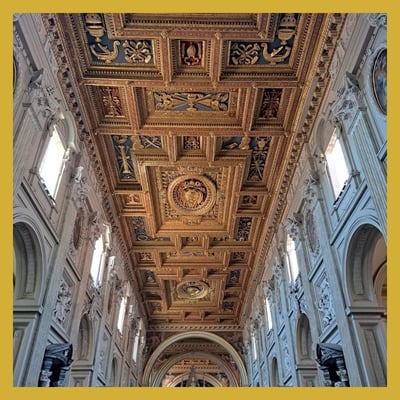

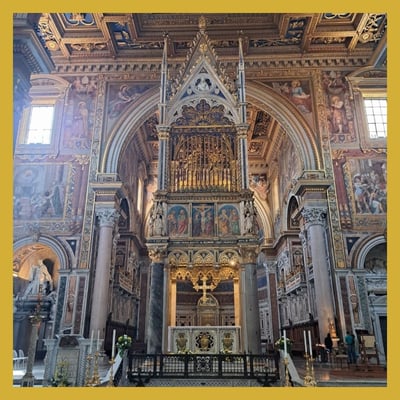

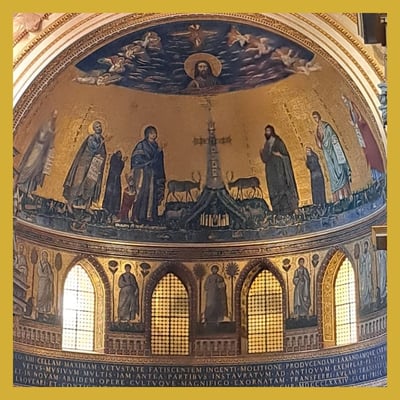

The Holy Stairs and the Sancta Sanctorum
The presence of the Holy Stairs and the Sancta Sanctorum represents one of the most unique and spiritually significant elements of the Basilica of St. John Lateran. These sites, steeped in history and devotion, draw pilgrims globally, particularly during the Jubilee.
The Holy Stairs
Located immediately adjacent to the Basilica of St. John Lateran, the Holy Stairs consist of twenty-eight marble steps that, according to Christian tradition, were trodden by Jesus during His Passion at the palace of Pontius Pilate in Jerusalem. Legend has it that these steps were transported to Rome by Saint Helena in the 4th century, following her pilgrimage to the Holy Land. Today, the Holy Stairs serve as a significant pilgrimage site, especially during the Jubilee, when the faithful ascend the steps on their knees, performing an act of penance and reflecting on Christ’s suffering
Architecturally, the Holy Stairs are shielded by a wooden covering to protect the original marble, yet openings allow glimpses of the marble which, tradition holds, was stained with the blood shed by Christ. This aspect imbues the site with a profound emotional and spiritual intensity. The journey up these stairs to the Sancta Sanctorum offers a deep, contemplative experience of prayer.
The Sancta Sanctorum
The Sancta Sanctorum, which translates as the "Holy of Holies” — traditionally the most sacred inner part of a temple — houses some of the most hallowed relics of Christianity. Having originally served as the ancient papal chapel within the Lateran Palace, the Sancta Sanctorum is celebrated for its profound sanctity and the precious relics it safeguards, including pieces of the True Cross and remains of several saints among other venerated objects. Historically, access was restricted to the Pope alone, highlighting its status as one of the most sacred spaces in Rome
From an architectural standpoint, the Sancta Sanctorum is notable for its rich medieval mosaics, among the oldest and best preserved in Rome. These mosaics, depicting various biblical scenes, stand as remarkable examples of early Christian and medieval art, reflecting an enduring devotion across centuries. Additionally, the chapel is adorned with 13th-century frescoes, carefully restored over time to maintain their original luster.
The door of the Sancta Sanctorum, clad in bronze and embellished with bas-reliefs depicting scriptural scenes, symbolizes a profound transition from the earthly realm to the spiritual domain. The door’s solemnity and aesthetic enrich the spiritual significance of this revered site, further elevating its status within the sacred tradition..
The Holy Stairs and the Sancta Sanctorum are deeply embedded in the spiritual tradition of Rome and the Basilica of St. John Lateran. These sacred sites provide the faithful with a profound connection to the storied rituals of sacred history and are pivotal to the practices of penance and prayer in the Catholic faith. During the Jubilee, these locations become central in the celebrations of forgiveness and mercy, drawing thousands of pilgrims who are eager to walk in the footsteps of Christ and seek closer communion with the divine through prayer and personal sacrifice.
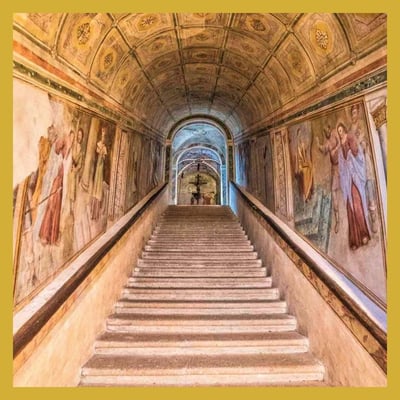

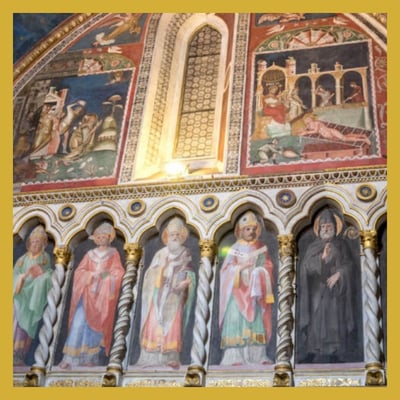

Drop us a line
Follow us
Discover the Jubilee
Experience the Jubilee
Jubilee locations
Get ready for the Jubilee
Rome and the Jubilee
